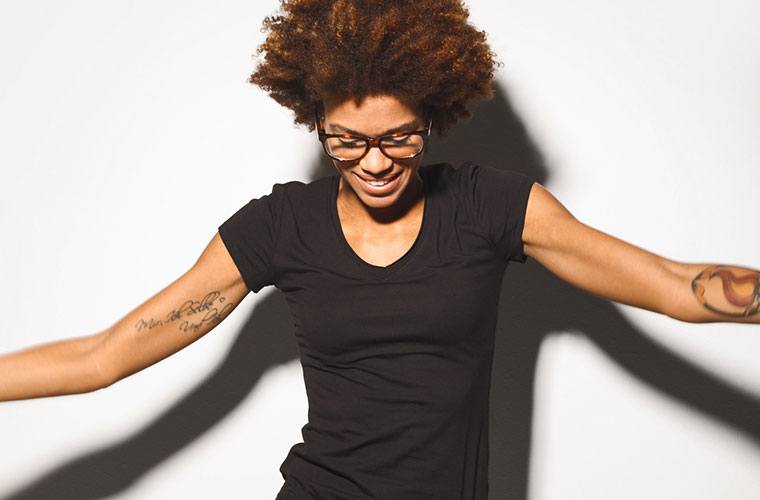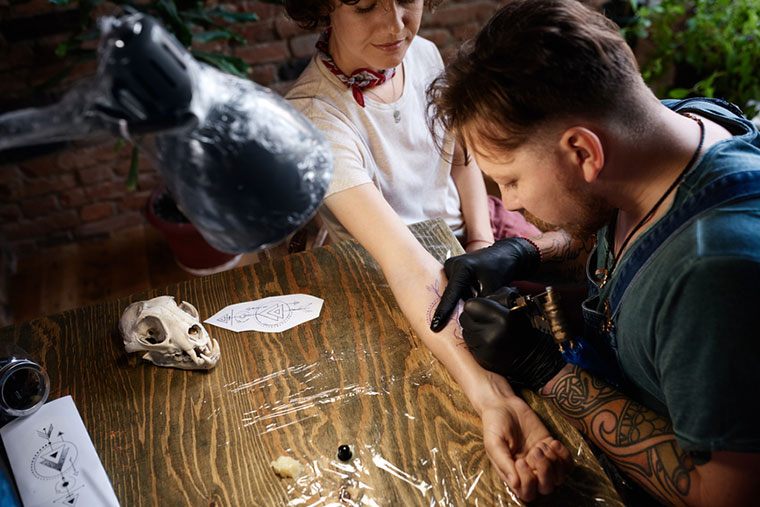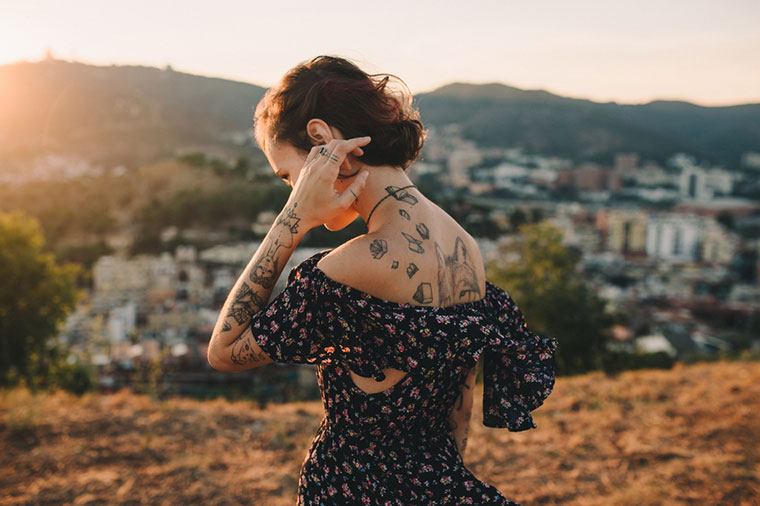Can Getting a Tattoo Be a Spiritual Experience? I Tried It to Find Out
I always laugh when people ask about my tattoos, then back off and say, “Or maybe you don’t want to talk about it.” Of course I want to talk about it. I had something drawn permanently on my body. You don’t think I have a story to tell?
They reveal who I am, reflect journeys I’ve made and the person I’ve become: Take the lotus-blossom motif I got after a retreat in India, which I half-jokingly refer to as my "divorce tattoo." That one was healing and empowering—as were the others before and after. (I have five in all.) Which is why, when I found myself traveling in Thailand earlier this year, I jumped at the chance to sit for a sak yant (AKA sacred tattooing) session with Arjarn Boo, a former monk who studied with the master who did one of Angelina Jolie’s pieces.
He determined that what I needed was a specific prayer signifying a blessing that I would be better able to receive and give kindness.
He's now the resident tattoo artist at the luxurious Siam Hotel in Bangkok, but Arjarn Boo learned the ancient art form (which dates back over 2,000 years) in a monastery. Monks traditionally perform the tattoos (known for their intricate patterns, geometric shapes, and animal or deity designs) on one another in order to impart blessings and prayers for things like health, protection, or fortune.
When I met with him, we spoke through a translator, and he determined that what I needed was a specific prayer, written in the sacred language, signifying a blessing that I would be better able to receive and give kindness. He didn’t know anything about my life—and barely even spoke English—but his idea turned out to be spot on.
Scroll down to see the happened when I decided to take a leap of faith and get a sak yant in Thailand.

Coincidence or divine intervention?
I'd very recently moved from New York—my home of 20 years—to Lisbon, and found the transition harder than I'd expected. So, I'd left to attend the embracing change program at Kamalaya, a remote wellness resort on the island of Koh Samui in Thailand. There, I realized I'd been so hung up on the things that were frustrating or disappointing or difficult about life in Portugal that I'd lost sight of the fact that a lot of kindness was being extended to me. Enter Arjarn Boo with his blessing.

{{post.sponsorText}}
Was it coincidence or divine intervention? IDK. But what I did know was that understanding how he'd settled on this particular prayer—he doesn't offer clients a lot of explanation or choice on the sak yant itself (other than size and location)—didn't feel so important as I sat in his studio amongst his Buddha statues, lotus blossoms, incense, candles, and water offerings. What mattered more was that my tattoo, located on my right forearm (I wanted it in a place where I could see it), would be a single, long line rather than the more common pattern of five or seven shorter ones typically used in the tradition. After a (brief) discussion, followed by prayers, offerings, and blessings, Arjarn Boo—shy, reserved, and wearing all white—quietly set to work.
I was relieved to find that the procedure, hand-done, with a traditional long needle, turned out to be no more painful than a tattoo with an electric one.
While in modern tattooing, artists generally trace the design on special paper, transfer that drawing to the skin, and then go over it with a needle, he simply drew a straight line on my forearm and used it as a guide as he freehanded the actual tattoo tap by tap. (Forearms are really hard, FYI, because of the way your ulna and radius rotate and the skin moves around, so "straight line down the middle" ends up being kind of subjective.) Anyway, that made it seem like he was drawing with confidence and maybe even intuition.
And I was relieved to find that the procedure, hand-done, with a traditional long needle, turned out to be no more painful than a tattoo with an electric one (which is commonly compared to a cat scratch—albeit one that's deep, slow, extended, and repeated). This was less intense—it felt like a series of pinpricks—and he took a lot of breaks to add ink to the needle.
More than the pain, what I noticed was the quiet. Other than the translator occasionally asking me if I was holding up all right, there was really no noise during my 30-minute session. Without the unpleasant drone of an electric needle, I was able to reflect on the meaning of the tattoo, my intentions for it, and my choice to invest in it. (Sak yant as the Siam Hotel costs between $900 and $1,800 USD.) The lack of sound—along with the offerings I made at the altar and the prayers Arjarn Boo intoned—heightened the experience. But could it be called spiritual?

The healing power of permanent ink
Historically, sak yant's been more about divine blessings than internal, personal growth. But Arjarn Boo tells me it can be both. “It depends on the behavior of the wearer," he explains. "What matters most is the self-discipline and morality of the [individual]—if they think good, speak good, and do good, good things will return to [them].” So, basically become a boomerang for positive vibes.
And it’s not just ancient societies (think: Maori people of New Zealand, who have a form of skin art known as MOKO, as well as other Buddhist traditions) for whom tattooing can be a divine act. In contemporary, Western culture, getting inked can be sacred, too, says Gabe Crenshaw, PhD, a lecturer at the University of Southern California. “The majority [of tattooers] exhibit a positive motivational basis for their behavior—they seek a deeper spiritual experience that has tangible results,” explains the psychology expert who appeared on Ink Shrinks, a TV special about the potential healing power of permanent body art that aired on SpikeTV in 2014.
"Because endorphins produce feelings of well-being, the tattoo plays a significant role in the therapeutic process by providing relief from emotional pain."
Although there's little scientific research into the spiritual side effects of tattoos, studies have found that painful stimulation releases endorphins in the body. “Because endorphins produce feelings of well-being, the tattoo plays a significant role in the therapeutic process by providing relief from emotional pain, relaxation, and clarity," says Dr. Crenshaw. So, would I still feel as happy and transformed once the pain subsided?

What happened once the ink dried
Sometimes fresh tattoos bleed or are even a little scabby, but my arm was just slightly red when the session ended. And while you normally have to wrap a new piece in plastic for a day, keep it absolutely dry, and sometimes even have to change that dressing as it oozes, Arjarn Boo said that wouldn't be necessary and would actually be counterproductive.
Instead, I was sent out with a pot of Vaseline (I know, I know, petroleum, but it was still Thailand—I imagine any kind of mild unguent would have worked, but I didn't think to ask) that I was supposed to apply twice a day. I was told to avoid putting soap or shampoo on it for a week. And finally, in addition to the everyday healing directions, sak yant comes with lifelong after-care instructions: In my case, not eating star fruit—not a big sacrifice—and not disrespecting anyone’s mother, which is generally a good policy.
And while I loved it then, I love it more now—especially because I think it's helped me; however, I also did a lot of my own emotional work. Since getting my sacred tattoo, I've become better at accepting kindness (giving it has never been my problem, but I pay more attention to my opportunities to do so today) and happier with my life. Plus, I like telling the story.
Looking to do some energetic healing, here's what happened to another writer who tried intuitive tattooing. And this is why your permanent ink might be changing the way you sweat.
Loading More Posts...